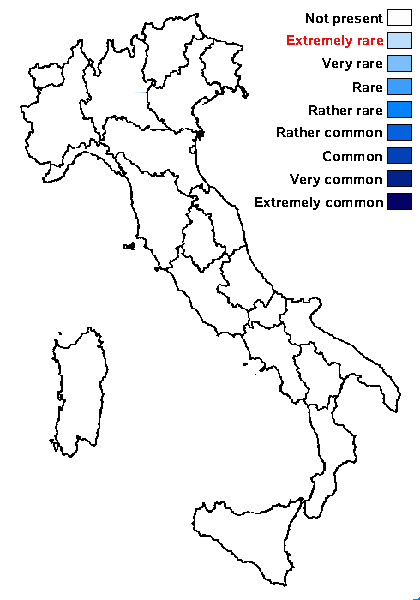Placidium velebiticum (Zahlbr. ex Zschacke) Breuss
Ann. naturhist. Mus. Wien, Ser. B, Bot. Zool., 98, suppl.: 39, 1996. Basionym: Dermatocarpon velebiticum Zahlbr. ex Zschacke - Rabenh. Krypt.-Fl., 2nd ed., 9, 1, 1: 629, 1934
Synonyms: Catapyrenium pyrenaicum Breuss & Etayo; Placidium pyrenaicum (Breuss & Etayo) Breuss
Distribution:
Description: Thallus squamulose to subfoliose, pale brown, dull to somewhat shiny, the squamules large, up to 15 mm wide, 0.27-0.36 mm thick, densely aggregated to overlapping, rounded at tips, with a mostly up-turned, undulate margin bearing black, knotty pycnidia. Lower surface pale to dark brown in marginal parts, often blackening in central parts, attached by colourless, 4-6 μm thick rhizohyphae. Upper cortex paraplectenchymatous, 25-67 μm thick, of 7-16 μm wide cells, with a very thin or lacking epinecral layer; medulla prosoplectenchymatous, of elongated cells, 70-250 μm thick; lower cortex clearly delimited from the medulla, 27-77 μm thick, with 6-20 μm wide, rounded to angular cells which are arranged irregularly or in distinct vertical rows. Perithecia frequent, laminal, pyriform, immersed in the squamules, up to 0.5 mm across, without involucrellum. Exciple pale throughout; paraphyses absent, substituted by periphyses. Asci 8-spored, cylindrical, thin-walled, non-amyloid and without an ocular chamber, with uniseriately arranged spores, 75-90 × 12-17 μm. Ascospores 1-celled, hyaline, thin-walled, ellipsoid, (11-)13-17(-18) x 5-7 μm. Pycnidia multilocular, Dermatocarpon-type, mostly marginal, usually abundant, prominent and knob-like, black. Conidia oblong-ellipsoid, 3-5 x 1-2 μm. Photobiont chlorococcoid. Spot tests: cortex and medulla K-, C-, KC-, P-, UV-. Chemistry: without lichen substances.Note: on calciferous rocks and soil accumulated in rock fissures, sometimes overgrowing epilithic mosses, usually in more sheltered situations than those typical of P. rufescens, e.g. in open woodlands; the species has a wide, but scattered distribution in southern Europe; to be looked for in Italy.
Growth form: Squamulose
Substrata: rocks, soil, terricolous mosses, and plant debris
Photobiont: green algae other than Trentepohlia
Reproductive strategy: mainly sexual

Predictive model
Growth form: Squamulose
Substrata: rocks, soil, terricolous mosses, and plant debris
Photobiont: green algae other than Trentepohlia
Reproductive strategy: mainly sexual

Predictive model
 INDEX FUNGORUM
INDEX FUNGORUM
 GBIF
GBIF

